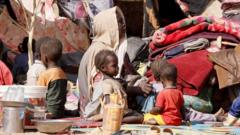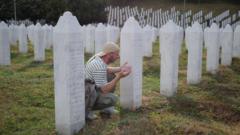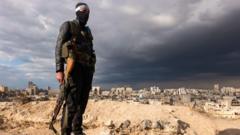Recent violence in Baniyas, where over 1,600 civilians were slaughtered, underscores the weak grip of the government and the ongoing sectarian tensions, as the new administration struggles to maintain order and protect the Alawite minority.**
Unrest in Baniyas: The Fragile State of Post-Civil War Syria**

Unrest in Baniyas: The Fragile State of Post-Civil War Syria**
A horrifying attack in the coastal city of Baniyas highlights the persistent violence and division in Syria, nearly 14 years after the onset of civil war.**
In early March, the coastal city of Baniyas in Syria reflected a grim tableau of destruction as an explosion of violence left over 1,600 civilians dead, predominantly from the Alawite community. While the world watches, what remains of normalcy in Syria continues to unravel.
Streets were strewn with the remnants of burned-out vehicles, shattered glass, and broken storefronts, a stark reminder of the recent terror. A makeshift morgue established at a looted furniture shop bore witness to the slaughter. Emergency workers handled body bags with grim efficiency as residents desperately sought to locate their missing family members amid the chaos.
The assault lasted a harrowing three days when a large group of armed individuals moved through the city, systematically executing civilians in a spree fueled by deep-rooted sectarian animosities. Eyewitness accounts paint a disturbing image of the violence, with reports of bodies being dumped in public squares and pleads for assistance echoing through the ruins.
The shocking events reveal the fragility of the peace purportedly established after the civil war, as the new government, largely comprised of rebel forces, struggles to assert control and protect its citizens, particularly those from the Alawite sect. Although historically influential during the Assad regime, the Alawites now find themselves under siege, marked by a spectrum of grievances against the rising tides of hostility.
As the dust settles on this grim chapter in Baniyas, it becomes increasingly clear that the path to recovery in post-civil war Syria remains fraught with peril. The international community closely watches, but the plight of the citizens caught in this turmoil may not require an audience; they need security, trust, and a chance to heal from the wounds of war.
Streets were strewn with the remnants of burned-out vehicles, shattered glass, and broken storefronts, a stark reminder of the recent terror. A makeshift morgue established at a looted furniture shop bore witness to the slaughter. Emergency workers handled body bags with grim efficiency as residents desperately sought to locate their missing family members amid the chaos.
The assault lasted a harrowing three days when a large group of armed individuals moved through the city, systematically executing civilians in a spree fueled by deep-rooted sectarian animosities. Eyewitness accounts paint a disturbing image of the violence, with reports of bodies being dumped in public squares and pleads for assistance echoing through the ruins.
The shocking events reveal the fragility of the peace purportedly established after the civil war, as the new government, largely comprised of rebel forces, struggles to assert control and protect its citizens, particularly those from the Alawite sect. Although historically influential during the Assad regime, the Alawites now find themselves under siege, marked by a spectrum of grievances against the rising tides of hostility.
As the dust settles on this grim chapter in Baniyas, it becomes increasingly clear that the path to recovery in post-civil war Syria remains fraught with peril. The international community closely watches, but the plight of the citizens caught in this turmoil may not require an audience; they need security, trust, and a chance to heal from the wounds of war.




















